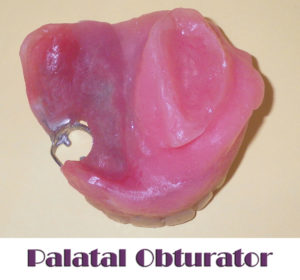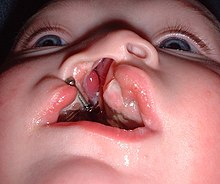obturator cleft palate
Cleft lip and palate is a birth defect occurring in the orofacial region. The oral appliance helps infants with suction when feeding.

Espras Share Closure Of Cleft Palates
Feeding obturator bridges the space and facilitates feeding.

. An apparatus designed to close an unnatural opening as a fissure of the palate. They are needed when individuals have cleft palates. Many methods have been devised to overcome these problems including the use of special bottles nipples and initial obturator therapy.
A cleft lip contains an opening in the upper lip that may extend into the nose. Years of experience in the field of cleft lip and palate showed me that an early operation that improves the muscular system and precisely speaking reconstructing the continuity of the orbicularis oris muscle inhibits the uncontrolled growth of the premaxilla the middle bone just under the nose that is why I dont support the idea of using Continue Reading. Palatal obturators are typically short-term prosthetics used to close defects of the hardsoft palate that may affect speech production or cause nasal regurgitation during feeding.
Here we present a case of a 5-day-old infant with unilateral cleft lip and palate for whom feeding obturator was made by using a simplified impression technique to facilitate. For adults and children the prosthesis makes it easier to eat and swallow so they can get adequate nutrition. A Serving as an obturator.
Cleft palate leads to oroantral communication and also malformations of the palate and. Author links open overlay panel John J. The meatus obturator in cleft palate prosthesis.
It also aids in clear communication and helps reduce the anxiety that speech impairment can cause. The palatal obturator is also used when there is tissue loss and can be downsized for strengthening of the tissue to occur. This condition occurs when the two plates of the skull that form the hard palate do not completely join together resulting in a gap in the roof of the mouth.
In order to be successful in sucking coordination of the intraoral muscles is important which. Feeding these babies is an immediate concern because there is evidence of delayed growth of children with cleft lip and palate CLCP compared to normal infants. Always clean a palatal obturator twice a day to prevent buildup and bacteria.
An obturator is necessary to artificially close the gap until it can be surgically corrected. This article presents a case report of a neonate with cleft lip and palate in whom a feeding obturator was delivered. Many methods have been devised to.
Feeding these babies is an immediate concern because there is evidence of delayed growth of children with cleft lip and palate CLCP compared to normal infants. Following surgery there may remain a residual oronasal opening on the palate alveolar ridge or labial vestibule. A polydimethylsiloxane obturator for hard palate clefts is described.
As the obturator nerve. But a cleft obturator is often and appropriately recommended when the opening in the palate is large enough to interfere with the feeding growth and development of a child. Cleft lip and palate is one of the most common congenital anomalies.
An obturator can be used in this situation to help patients regain their abilities. A palatal obturator is a prosthesis that totally occludes an opening such as an oronasal fistula. A palatal obturator is a prosthesis that totally occludes an opening such as an oronasal fistula in the roof of the mouth.
Tissue openings of the palate and contiguous structures. This will ensure that a baby is getting the food and nutrients he or she needs. A cleft palate is when the roof of the mouth contains an opening into the nose.
Inborn cleft lip and palate is utmost encountered craniofacial anomaly. Sucking efficiency is one of the most common difficulties related to feeding in children with cleft lip and palate. Cleft lip and cleft palate previously known as hare-lip is a group of conditions that includes cleft lip cleft palate and both together.
The opening may be on one side both sides or in the middle. Download Citation OBTURATOR PROSTHESIS TO REHABILIT PALATE AND KENNEDY CLAS III PATIENT Background. The material used nasal regurgitation.
Types of Palatal Obturators Palatal plate used to improve speech and feeding. The primary goals of the obturator prosthesis are to preserve the remaining teeth and tissue and to provide comfort function and aesthetics to the patients. Following surgery there may remain a.
A variety of molded prosthetics may be used in the first few weeks of the babys life to help shape the cleft palate into a more-favourable position for surgery. Pertaining to or in the region of the obturator foramen. Because it is soft the obturator uses anatomic undercuts of the nasal cavity fo.
A prosthesis used to close a palatal defect in a dentate or edentulous mouth is referred to as an obturator. A feeding obturator is a prosthetic aid that is designed to obturate the cleft and restore the separation between oral and nasal cavities. In some cases the fistula is temporarily covered for example a fistula caused by cleft palate is often treated with a palatal obturator to delay the need for surgery to a more appropriate age.
One of the immediate problems to be addressed in a newborn with this defect would be to aid in suckling and swallowing. The ultimate issue a newborn with cleft lip and palate faces is the crisis in feeding nasal puke and choking which additionally leads to nutrition scarcity and ultimately affects the overall grown of an infant. Treatment of this deformity presents a serious problem for health delivery systems all over the world.
In severe cases a prosthetic device known as a palatal obturator which closes off the cleft may be needed. Palatal obturators are typically short-term prosthetics used in order to close defects of the hardsoft palate that may effect speech production or cause nasal regurgitation during feeding. The obturators are prosthesis used to close palatal defects after maxillectomy to restore masticatory function and to improve speech.
A feeding obturator is a necessity for a child who is born Primary impression was taken using rubber base impression with cleft palate since it helps the infant to feed without material on a previously fabricated tray. The obturator prosthesis is used to restore masticatory function and improve speech deglutition and cosmetics for maxillary defect patients 5. They are similar to dental retainers but without the front wire.
Cleft palate was found in 981 of fetuses in the positive control group and none of them in the negative control group. An obturator is recommended for infants with a cleft palate because proper feeding is essential for normal development.

Cleft Palate Prosthesis A Prosthetic Solution New Smile Prosthodontics

Above Right Preoperative Photograph Of The Cleft Palate Patient Download Scientific Diagram

Palliative Care Through Single Visit Flexible Feeding Aid For An Infant With Pierre Robin Sequence A Clinical Report

Simplified Feeding Appliance For An Infant With Cleft Palate

Simplified Feeding Appliance For An Infant With Cleft Palate

Figure 6 From Feeding Obturator For A 3 Day Old Neonate With Cleft Lip And Palate A Clinical Report Semantic Scholar

Pre Surgical Orthopedics In Newborn Patients With Cleft Lip And Palate Revista Mexicana De Ortodoncia

Pdf A Feeding Appliance For A Newborn Baby With Cleft Palate Semantic Scholar

Pdf Fabrication Of A Passive Feeding Plate Using Indirect Composite A Novel Technique

Feeding Plate Palatal Obturator Download Scientific Diagram

Pdf Rehabilitation Of A One Day Old Neonate With Cleft Lip And Palate Using Palatal Obturator A Case Report

What S A Palatal Obturator Pi Dental Center
Obturator Prostheses For Cleft Lip And Palate Patients Portal Myhealth

Intra Oral View Of The Cleft Figure 3 Cast Palatal Plate With Acrylic Download Scientific Diagram
Obturator Prostheses For Cleft Lip And Palate Patients Portal Myhealth

Pdf Oral Molding Plates A Boon To Cleft Lip And Cleft Palate Patients A Series Of Case Reports And Review Semantic Scholar



0 Response to "obturator cleft palate"
Post a Comment